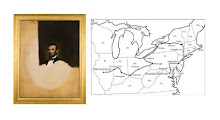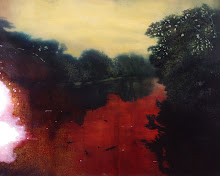Thursday, August 5, 2010
Leaving Hudson this morning I experienced very high humidity and dense air. Keeping myself hydrated was the primary goal in the morning. The Hudson River Valley can hold this weather in what seems to be an imovable front. However, I was almost ignoring all of this because everywhere I looked in the farmland, the scenery appeared to be taken verbatim from a Frederik Church painting. Melodramatic sun rays would shine down on golden grasses with horses eating hay and the distant fields would appear a softer green in color as they receeded into the background. This place is a landscape painter's dream lesson for atmospheric perspective. I can see why Church, and for that matter, John Kensett (another Hudson River painter) became so interested in light and atmosphere. This was their workshop!
Approaching Poughkeepsie, the same holds here for the weather conditions. Lincoln spoke more at length in this city and seemed more serious in tone. The dramatic perspectives and monumental views of the Hudson River at this location perhaps suggested this timely reflection. Pointing out in his speech that it wasn't the country that needed saving, Mr Lincoln emphasized that it was the Nation's institutions and what they were based on,- that needed saving. This was Lincoln's main work and prime objective of his presidency.
But this would not be an easy task, as the US needed money. Right before I entered Poughkeepsie, I rode into Hyde Park and onto the grounds of the Cornelius Vanderbilt estate. One of the richest men in the world (in the 19th century), Vanderbilt held what amounted to 1/9 of the US currency in his hand. (Bill Gates is estimated to hold 1/138). Mr Lincoln would eventually ask for Vanderbilt's help and he donated one million dollars to outfit a warship to bottle up the southern ship "Virginia" at Hampton Roads. The first 'ironclad' fight changed Naval warfare forever and launched an industrial 'north' into the business of building iron battleships. Vanderbuilt came to exemplify what a post Civil War economy would look like in the US as the medieval fifedoms of southern planations collapsed. A new kind of society was born in America and it would move into the next century and it was based on an industrialized economy. The 20th century so happens to appear just down the street of the Vanderbilt estate. My next stop was the home and library of President Franklin D. Roosevelt.
Approaching Poughkeepsie, the same holds here for the weather conditions. Lincoln spoke more at length in this city and seemed more serious in tone. The dramatic perspectives and monumental views of the Hudson River at this location perhaps suggested this timely reflection. Pointing out in his speech that it wasn't the country that needed saving, Mr Lincoln emphasized that it was the Nation's institutions and what they were based on,- that needed saving. This was Lincoln's main work and prime objective of his presidency.
But this would not be an easy task, as the US needed money. Right before I entered Poughkeepsie, I rode into Hyde Park and onto the grounds of the Cornelius Vanderbilt estate. One of the richest men in the world (in the 19th century), Vanderbilt held what amounted to 1/9 of the US currency in his hand. (Bill Gates is estimated to hold 1/138). Mr Lincoln would eventually ask for Vanderbilt's help and he donated one million dollars to outfit a warship to bottle up the southern ship "Virginia" at Hampton Roads. The first 'ironclad' fight changed Naval warfare forever and launched an industrial 'north' into the business of building iron battleships. Vanderbuilt came to exemplify what a post Civil War economy would look like in the US as the medieval fifedoms of southern planations collapsed. A new kind of society was born in America and it would move into the next century and it was based on an industrialized economy. The 20th century so happens to appear just down the street of the Vanderbilt estate. My next stop was the home and library of President Franklin D. Roosevelt.
Subscribe to:
Post Comments (Atom)






No comments:
Post a Comment